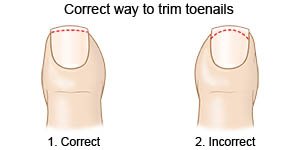Nail Removal
Medically reviewed by Drugs.com. Last updated on Aug 4, 2025.
Nail removal can prevent infection, decrease ingrown nail pain, and help the nail heal from an injury. You may need to have all or part of your nail removed.
DISCHARGE INSTRUCTIONS:
Seek care immediately if:
- Blood soaks through your bandage.
- You have a red streak running up your leg or arm.
Contact your healthcare provider if:
- You have a fever or chills.
- Your wound is red, swollen, or draining pus.
- Your pain is getting worse.
- You have questions or concerns about your condition or care.
Related medications
Medicines:
You may need any of the following:
- Antibiotics help treat or prevent a bacterial infection.
- Antifungal medicine helps treat or prevent a fungal infection. It may be given as a cream or a pill.
- Prescription pain medicine may be given. Ask your healthcare provider how to take this medicine safely. Some prescription pain medicines contain acetaminophen. Do not take other medicines that contain acetaminophen without talking to your healthcare provider. Too much acetaminophen may cause liver damage. Prescription pain medicine may cause constipation. Ask your healthcare provider how to prevent or treat constipation.
- Take your medicine as directed. Contact your healthcare provider if you think your medicine is not helping or if you have side effects. Tell your provider if you are allergic to any medicine. Keep a list of the medicines, vitamins, and herbs you take. Include the amounts, and when and why you take them. Bring the list or the pill bottles to follow-up visits. Carry your medicine list with you in case of an emergency.
Self-care:
- Elevate your hand or foot above the level of your heart as often as you can for 24 hours. This will help decrease swelling and pain. Prop your hand or foot on pillows or blankets to keep it elevated comfortably.
- Keep your nail area clean, dry, and covered. When you are allowed to bathe, carefully wash the area with soap and water. Put on a clean, new bandage. Do not use an adhesive bandage. It may stick to the wound and cause pain when you remove it. Ask your healthcare provider what kind of bandage to use. Change your bandage when it gets wet or dirty. Your healthcare provider may suggest that you change the bandage every 24 hours for the first few days.
- Ask when you can return to work , school, or your usual sports and activities.
- Prevent an ingrown nail. Trim your nails straight across. Do not cut them too short. Do not round the corners. Do not rip or tear off the tips of your nails.

- Do not wear tight shoes or shoes that do not fit well. Do not wear tights or pantyhose. Wear cotton socks.
Follow up with your healthcare provider as directed:
You may need to return to have stitches removed. Write down your questions so you remember to ask them during your visits.
© Copyright Merative 2025 Information is for End User's use only and may not be sold, redistributed or otherwise used for commercial purposes.
The above information is an educational aid only. It is not intended as medical advice for individual conditions or treatments. Talk to your doctor, nurse or pharmacist before following any medical regimen to see if it is safe and effective for you.
Further information
Always consult your healthcare provider to ensure the information displayed on this page applies to your personal circumstances.
